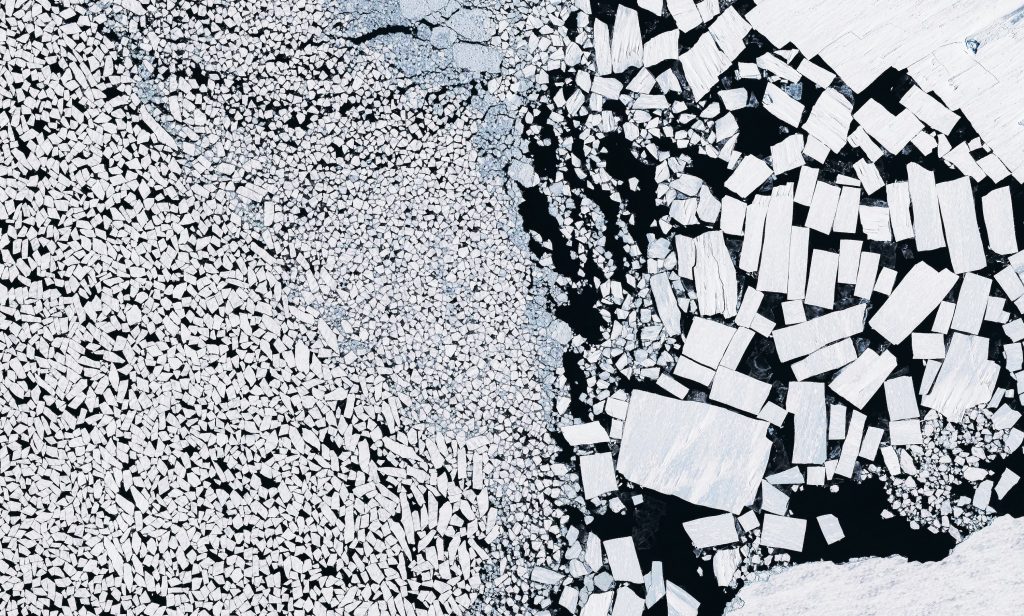
By: The Posts Author | Posted on: 5 Feb 21
Challenging perceptions of time and place to enhance climate change engagement through museumsLong Now co-founder Brian Eno in front of his 77 Million Paintings generative artwork (02007).By Henry McGhie*, Sarah Mander**, Asher Minns***AbstractThis article proposes that applying time-related concepts in museum exhibitions and events can contribute constructively to people’s engagement with climate change. Climate change now and future presents particular challenges as it is perceived to be psychologically distant. The link between this distance and effective climate action is complex and presents an opportunity for museums, as sites where psychological distance can be explored in safe, consequence-free ways. This paper explores how museums
Challenging perceptions of time and place to enhance climate change engagement through museumsLong Now co-founder Brian Eno in front of his 77 Million Paintings generative artwork (02007).By Henry McGhie*, Sarah Mander**, Asher Minns***AbstractThis article proposes that applying time-related concepts in museum exhibitions and events can contribute constructively to people’s engagement with climate change. Climate change now and future presents particular challenges as it

By: The Posts Author | Posted on: 12 Nov 20
Antarctic Sea Ice Melt — 02019 (Source: Maxar) The Ancient Greeks had two different words fortime. The first, chronos, is time as we think of it now: marching forward, ceaselessly creating our past, present, and future. The second, kairos, is time in the opportune sense: the ideal moment to act, as captured by the phrase, “It’s time.” My work, like many other photographers, has been a dedicated search forkairos — finding that ideal confluence of place and time that helps to tell a particular story. For me, that story has focused on the manmade world. In 02013, I launched Daily Overview, which features compositions created
Antarctic Sea Ice Melt — 02019 (Source: Maxar) The Ancient Greeks had two different words fortime. The first, chronos, is time as we think of it now: marching forward, ceaselessly creating our past, present, and future. The second, kairos, is time in the opportune sense: the ideal moment to act, as captured by the phrase, “It’s time.” My work, like many other

By: The Posts Author | Posted on: 12 Nov 20
Antarctic Sea Ice Melt — 02019 (Source: Maxar) The Ancient Greeks had two different words fortime. The first, chronos, is time as we think of it now: marching forward, ceaselessly creating our past, present, and future. The second, kairos, is time in the opportune sense: the ideal moment to act, as captured by the phrase, “It’s time.” My work, like many other photographers, has been a dedicated search forkairos — finding that ideal confluence of place and time that helps to tell a particular story. For me, that story has focused on the manmade world. In 02013, I launched Daily Overview, which features compositions created
Antarctic Sea Ice Melt — 02019 (Source: Maxar) The Ancient Greeks had two different words fortime. The first, chronos, is time as we think of it now: marching forward, ceaselessly creating our past, present, and future. The second, kairos, is time in the opportune sense: the ideal moment to act, as captured by the phrase, “It’s time.” My work, like many other

By: The Posts Author | Posted on: 6 Nov 20
In an article in Forbes, David Bressan writes that the giant rift in the USA’s political voting blocs is in part a consequence of collisions between continental plates, the literal giant rift that used to separate the two halves of North America, and recent glacial activity: The same region that had once been covered in ocean water, leading to the fertile Black Belt, was almost an exact replica of the districts that had voted for Clinton. The rich coal fields in Ohio, West Virginia, Pennsylvania and Maryland formed as a result of two continents colliding some 300 million years ago.
In an article in Forbes, David Bressan writes that the giant rift in the USA’s political voting blocs is in part a consequence of collisions between continental plates, the literal giant rift that used to separate the two halves of North America, and recent glacial activity: The same region that had once been covered in ocean water, leading to the

By: The Posts Author | Posted on: 27 Oct 20
Once again on the theme of how the technological/cultural pace layer’s accelerating decoupling from the ecological pace layer in which we evolved poses serious risks to the integrity of both the human body and biosphere: When daycare workers in Finland rolled out a lawn, planted forest undergrowth such as dwarf heather and blueberries, and allowed children to care for crops in planter boxes, the diversity of microbes in the guts and on the skin of young kids appeared healthier in a very short space of time.Compared to other city kids who play in standard urban daycares with yards of pavement,
Once again on the theme of how the technological/cultural pace layer’s accelerating decoupling from the ecological pace layer in which we evolved poses serious risks to the integrity of both the human body and biosphere: When daycare workers in Finland rolled out a lawn, planted forest undergrowth such as dwarf heather and blueberries, and allowed children to care for crops

By: The Posts Author | Posted on: 26 Oct 20
Inside Finland’s Olkiluoto nuclear waste repository, 1,500 feet underground. Photo Credit: Peter Guenzel With half-lives ranging from 30 to 24,000, or even 16 million years, the radioactive elements in nuclear waste defy our typical operating time frames. The questions around nuclear waste storage — how to keep it safe from those who might wish to weaponize it, where to store it, by what methods, for how long, and with what markings, if any, to warn humans who might stumble upon it thousands of years in the future — require long-term thinking. These questions brought the anthropologist Vincent Ialenti to Finland’s Olkiluoto nuclear waste repository in
Inside Finland’s Olkiluoto nuclear waste repository, 1,500 feet underground. Photo Credit: Peter Guenzel With half-lives ranging from 30 to 24,000, or even 16 million years, the radioactive elements in nuclear waste defy our typical operating time frames. The questions around nuclear waste storage — how to keep it safe from those who might wish to weaponize it, where to store it, by what
By: The Posts Author | Posted on: 4 Aug 20
Archaeologist Stefani Crabtree writes about her work to reconstruct Indigenous food and use networks for the National Park Service: Traditional Ecological Knowledge gets embedded in the choices that people make when they consume, and how TEK can provide stability of an ecosystem. Among Martu, the use of fire for hunting and the knowledge of the habits of animals are enshrined in the Dreamtime stories passed inter-generationally; these Dreamtime stories have material effects on the food web, which were detected in our simulations. The ecosystem thrived with Martu; it was only through their removal that extinctions began to cascade through the
Archaeologist Stefani Crabtree writes about her work to reconstruct Indigenous food and use networks for the National Park Service: Traditional Ecological Knowledge gets embedded in the choices that people make when they consume, and how TEK can provide stability of an ecosystem. Among Martu, the use of fire for hunting and the knowledge of the habits of animals are enshrined

By: The Posts Author | Posted on: 24 Jul 20
I want to talk to all of you today about the humans that survived the current planetary predicament. How did they organize their lives? What was the key to their success? It is no secret that we are in the midst of a severe period of ecological collapse. The exploding human population lay flat on its growth curve for hundreds of thousands of years until the invention of industrial agriculture. Then it shot skyward in an exponential arc corresponding with the rapid depletion of intact ecosystems, healthy environments, and stored materials across the Earth. All of this happened in the
I want to talk to all of you today about the humans that survived the current planetary predicament. How did they organize their lives? What was the key to their success? It is no secret that we are in the midst of a severe period of ecological collapse. The exploding human population lay flat on its growth curve for hundreds

By: The Posts Author | Posted on: 19 Mar 20
It is starting to feel like a specific kind of cascading collapse may be upon us.As the Coronavirus spreads virally, the gutted social supports left in the 40 year wake of Neoliberal Capitalism are causing many people to lose their jobs; need to find ways to take care of their kids while continuing to work; and generally be on their own to fight for survival.The population overshoot enabled by the Green Revolution and fossil fuels has created a globalized consumer market economy that degraded many landscapes and polluted nearly everything.The nation states of the world are proving to be ill-equipped to
It is starting to feel like a specific kind of cascading collapse may be upon us.As the Coronavirus spreads virally, the gutted social supports left in the 40 year wake of Neoliberal Capitalism are causing many people to lose their jobs; need to find ways to take care of their kids while continuing to work; and generally be on their own
By: The Posts Author | Posted on: 18 Mar 20
I would like to share a little glimpse into how we are weaving regenerative practices into our lives while becoming more resilient in the midst of planetary turmoil as people all over the world struggle to deal with the Coronavirus pandemic.In the image above, our three year old daughter Elise is pulling our new compost bucket up the hill to where our food scraps become part of the formation process for soils in the community food forest.We live in Barichara, Colombia where six hectares have been set aside as a public park where reforestation has been underway for more than a
I would like to share a little glimpse into how we are weaving regenerative practices into our lives while becoming more resilient in the midst of planetary turmoil as people all over the world struggle to deal with the Coronavirus pandemic.In the image above, our three year old daughter Elise is pulling our new compost bucket up the hill to







